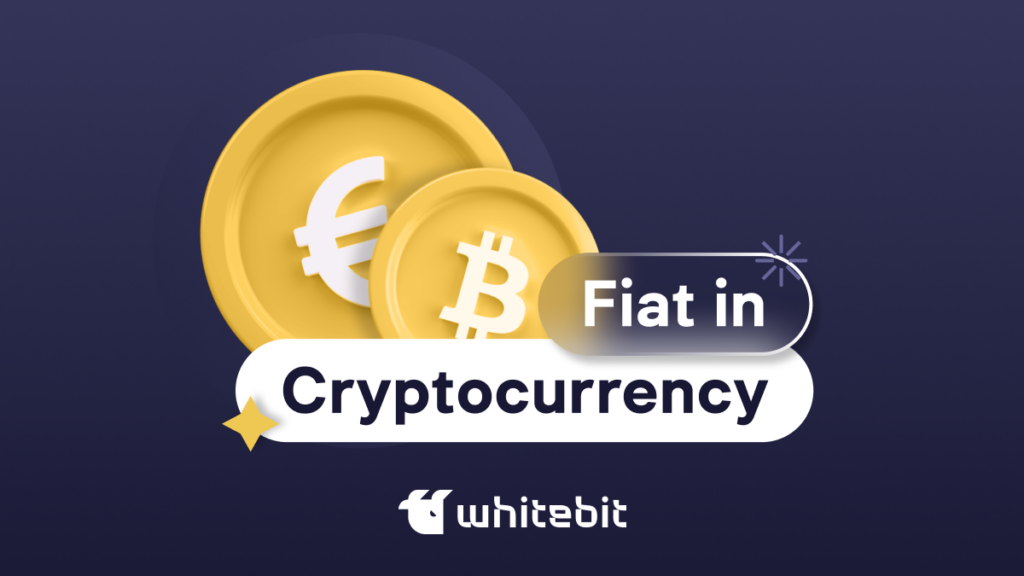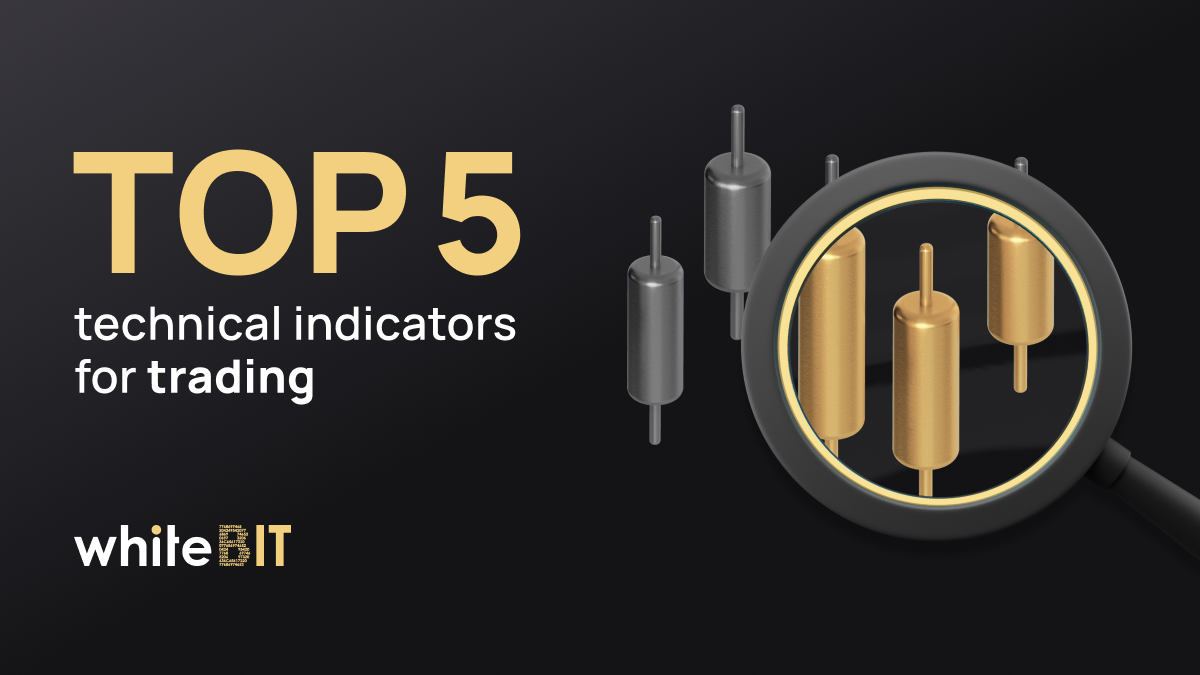What Is Fiat in Cryptocurrency

Content
- What Is Fiat Money in Cryptocurrency?
- History of the Fiat Currency
- Fiat Money Example
- The Role of Fiat Currencies in the Global Economy
- Fiat Development Trends: Digital Transformation
- Disadvantages and Benefits of Fiat Currency
- Cryptocurrency vs Fiat Currency
- Will Cryptocurrency Replace Fiat Currency?
- How to Buy Crypto with Fiat on WhiteBIT?
- Conclusion
- FAQ
In a digital age that forces us to rethink every aspect of our lives, it is natural to ask, “Is traditional money obsolete?” Bitcoin and blockchain have become the reality of our time, and virtual wallets in our smartphones have replaced wallets stuffed with paper bills.
With finance digitalizing and cryptocurrencies growing in interest, understanding the role of fiat money in the economy and its meaning in simple terms is vital. It helps to gain a deeper understanding of the mechanisms of financial markets, the impact of public policy on economic development, and how traditional and digital financial systems interact.
What Is Fiat Money in Cryptocurrency?
Fiat currency is a legal tender whose value is not backed by physical assets like gold or silver but is fixed by law. Its value is based solely on trust in the issuer (usually the government) and the requirement that it be accepted as a means of payment for goods and services.
The main features of fiat money include:
- They are issued by state central banks (CBs), and national governments and financial institutions regulate their issue and circulation.
- The value of fiat money is determined by general trust in the issuer and confidence in its ability to maintain economic stability.
- Fiat money is legal tender within a country, meaning it must be accepted as payment for debts.
Simply put, Fiat money is money we use daily: banknotes, coins, and digital money in bank accounts.
Unlike systems based on precious metals, a fiat is a tool that allows governments and central banks the flexibility to manage the economy through monetary policy instruments, such as interest rate regulation and open market operations, to stimulate economic growth or curb inflation.
The issuance and circulation of fiat currencies require high responsibility and transparency from governments and financial institutions to ensure currency stability and maintain public confidence. Mismanagement of the money supply, such as excessive issuance without economic justification, can lead to inflation or hyperinflation, undermining confidence in the currency and financial stability. Historical examples, such as hyperinflation in Zimbabwe in the early 2000s and the Weimar Republic in the 1920s, illustrate the consequences of such manipulations and emphasize the importance of prudent financial regulation in preventing economic crises.
History of the Fiat Currency
The fiat system, which has become the basis for most of the world’s economies, differs from previous systems in that its value is not conditioned on the physical content of gold or silver but is based on legislative support and confidence in the economic stability of the issuing state. This transition began in the 20th century and was finalized in 1971 when U.S. President Richard Nixon suspended the exchange of dollars for gold, ending the international gold standard and the Bretton Woods system. The move aimed to prevent a currency reserve crisis and gave states more flexibility in managing their national economies.
Fiat assets emerged in their modern form due to the constraints imposed by the gold standard, but the concept of money has older roots. In the 11th century, during the Song Dynasty, paper money, known as “jiaozi,” began to be used in China to facilitate trade. It is considered one of history’s first known examples of fiat money.
Consider examples from various countries to enhance understanding of the importance and role of fiat currencies in modern economies. For example, the above examples highlight the risks of mismanagement of fiat currencies. On the other hand, stable financial policies and strict money supply regulation in advanced economies such as Switzerland and Japan demonstrate how proper money supply management can contribute to economic stability and prosperity.
Paper Money
The first fiat currency was paper money, which appeared in China during the Tang Dynasty in the 7th century but became widespread during the Song Dynasty (960-1279). They were a revolutionary innovation that fundamentally changed economic practices. The emergence of this form of currency was a response to the need to facilitate trade and make the circulation of money more convenient in the face of growing economic prosperity and expanding market relations. Paper money simplifies the transaction process, eliminating the need to transport large quantities of metal coins. This concept only took root in Europe in the 17th century, after Europeans learned about the Chinese practice from their travels and trading expeditions to Asia.
Gold Standard
The gold standard is a monetary system in which a country’s economy uses gold as direct security for the value of the national currency. Introduced in the 19th century, the gold standard provided currency stability through the direct convertibility of money into gold at a fixed price. Anyone could exchange paper money for the appropriate amount of gold at a central bank. This system facilitated international trade and investment because gold was the universal equivalent of value. However, it also limited the ability of nations to issue currency, making the economy vulnerable to a country’s gold reserves and speculation in the gold market.
Fiat Money
Even though fiat money is a currency without intrinsic value, whose value relies on trust in the issuing state, it holds a stable position in the global economy, and its abandonment is not foreseen. At the same time, fiat is being actively integrated into new financial systems, including cryptocurrencies. Moreover, many states are actively exploring the possibility of creating their own central bank digital currencies (CBDCs), which indicates a desire to adapt classical financial instruments to modern digital realities. But what is fiat in crypto?
Meanwhile, with the emergence and proliferation of cryptocurrencies, fiat currencies have gained their protégés in the world of digital assets called stablecoins. These are also called fiat in cryptocurrency, meaning cryptocurrencies are pegged to a stable asset, most commonly the dollar. This phenomenon illustrates how fiat currencies are being integrated into the digital economy. Stablecoins serve as a bridge between traditional monetary systems and the new digital world, providing the stability and reliability of conventional money in a volatile crypto market.
Today, centralized fiat cryptocurrency exchanges facilitate interactions between fiat currencies and cryptocurrencies, allowing users to convert funds, for example, from USD to BTC, crypto borrow USDT, and more. With this functionality, fiat exchanges expand the availability and acceptability of crypto assets in the global market.
Fiat Money Example
The most significant examples of fiat money are the U.S. dollar (USD), the euro (EUR), the British pound sterling (GBP), the Japanese yen (JPY) and others. These currencies are key in international financial transactions, serving as the basis for most trade and investment transactions. The U.S. dollar, for example, is the world’s reserve currency, widely used in international settlements and as a standard of valuation for commodities on world markets, including oil and gold. The euro, in turn, serves as the primary currency of the European Union, enabling economic integration among member countries. The British pound and Japanese yen are also considered essential currencies on the world stage, reflecting their respective countries’ financial strength and stability.
The Role of Fiat Currencies in the Global Economy
The fiat market plays a significant role in the global economy, providing the basis for all financial transactions, from international trade to personal remittances. They allow central banks to manage national economies through monetary policy, regulating the money supply and interest rates and controlling inflation. Monetary policy enables central banks to stimulate the economy during recessions and curb overheating. An example of the significant impact of monetary policy on the national economy is the quantitative easing program conducted by the U.S. Federal Reserve in response to the 2008 financial crisis. By purchasing government bonds and other financial assets, the Fed significantly increased the monetary base, which helped stabilize the financial system and helped restore economic growth.
The following list also shows what role fiduciary money plays in the global economy:
- Providing the basis for all financial transactions
- Managing the national economy through monetary policy
- Regulating money supply, interest rates, and inflation
- Stimulating the economy during recessions and curbing overheating
- Facilitating international settlements and currency exchanges
- Globalizing the economy and creating opportunities for businesses and individuals.
Fiat Development Trends: Digital Transformation
In today’s world, fiat and cryptocurrency are undergoing significant changes due to the rapid development of digital technologies. The digitalization era brings new trends in the circulation, management, and use of fiat money. This transformation opens new horizons for the global economy, providing opportunities for increased transparency, security, and accessibility of financial services. At the same time, it poses new challenges for regulators, banks, and users to adapt to the rapidly changing digital environment.
Decentralization and Inclusion
With advances in technology, notably blockchain, new forms of fiat money, such as central bank digital currencies (CBDCs), are emerging that can help decentralize finance and increase financial inclusion.
CBDCs are digital versions of fiat currencies fully controlled by central banks. Unlike the traditional banking system, CBDCs use digital technology to increase the efficiency of payment systems and improve access to financial services. Although CBDCs often include distributed ledger technology (DLT) or blockchain, similar to that underlying many cryptocurrencies, they do not offer decentralized money management. All aspects of CBDCs (network access, issuance, transactions) remain under the oversight of a central bank.
Emission Mechanism
Unlike traditional fiat currency issuance, where an increase in the money supply can lead to its depreciation, CBDCs can precisely control the volume in circulation due to their digital nature. As a result, central banks can react quickly to changes in the economy, adapting the volume of money supply to maintain price stability and stimulate economic growth.
No Intermediaries
The introduction of CBDC can reduce the role of intermediaries in financial transactions. This lowers the cost of transactions for users by reducing fees and speeding up payment processing. Direct digital transactions between parties can increase the efficiency of the financial system and make it more accessible. In addition, reduced reliance on traditional financial institutions can increase competition and innovation in the fintech sector.
Disadvantages and Benefits of Fiat Currency
Fiat currency has several advantages:
- Facilitates international trade and financial transactions as it is accepted for circulation worldwide.
- Provides convenience and speed of payments in both physical and digital forms.
- Central banks can influence the economy through monetary policy.
That said, fiat money is not without its drawbacks, namely:
- Without physical collateral such as gold, fiat accounts, and currencies are at risk of depreciation.
- Their value is closely linked to the political and economic stability of the issuing country, making them vulnerable in times of crisis. Also, a loss of confidence in the issuer can lead to a decline in the currency’s value.
Cryptocurrency vs Fiat Currency
In finance, the debate about the future of monetary systems is constantly evolving, centered on the rivalry between fiat currencies and cryptocurrencies. Traditional money has long been the backbone of the global economy. On the other hand, cryptocurrencies, such as Bitcoin and Ethereum, are innovative financial instruments based on distributed ledger technology. These two systems offer different approaches to storage and exchange, raising questions about their mutual influence and possible future integration.
What Is the Difference between Fiat Money and Cryptocurrency?
Let’s take a look at the difference between cryptocurrency and fiat currency:
- Control and regulation. Fiat currencies are issued by central banks and regulated by governments, while cryptocurrencies operate in decentralized networks and are not subject to direct government control.
- Physical representation. Fiat exists in physical and digital forms (banknotes and coins). Cryptocurrencies, on the other hand, are exclusively digital assets.
- Value Assurance. The value of fiat money is based on the issuer’s credibility and the country’s economic situation. The crypto price is mainly driven by supply and demand in the market and a particular cryptocurrency’s technological and functional features.
- Access and usage. Fiat is widely used in all areas of the economy. Crypto assets have so far found their use in a more limited range of transactions, although their popularity and acceptance are growing.
Will Cryptocurrency Replace Fiat Currency?
This issue is the subject of debate and much analysis in the financial world. On the one hand, cryptocurrencies offer several attractive innovations: decentralization, blockchain transparency, transaction security, and reduced reliance on traditional financial institutions. These features make cryptocurrencies a powerful tool that can reform the modern monetary system.
However, despite the growing interest in and integrating cryptocurrencies into everyday financial transactions, several obstacles still need to be overcome to their full adoption as a universal payment definition. The key factors holding back widespread adoption are high volatility, legal uncertainty, scalability, and, last but not least, the need for widespread social acceptance.
Thus, although cryptocurrencies show the potential to change the financial landscape, it is premature to talk about their complete replacement of fiat money shortly. We will likely see the coexistence of these two systems, where each will play its role in different aspects of economic life. Many people wonder how to withdraw crypto into fiat and vice versa. In this case, a fiat money currency exchange is vital in accomplishing this. This furthers both financial systems’ integration and mutual acceptability, enriching the global economic landscape.
How to Buy Crypto with Fiat on WhiteBIT?
WhiteBIT is one of the largest crypto-fiat exchanges in Europe. It provides access to over 270 crypto-assets and 10+ fiat currencies, such as UAH, EUR, USD, TRY, GBP, PLN, GEL, BGN, CZK, and KZT.
Registered users of the exchange who have undergone identity verification can quickly buy crypto with fiat by replenishing their balance in various ways: by bank or crypto card, WhiteEX scratch card, and payment services such as Checkout, GEO Pay, etc. You can use an FIO address or external crypto wallet for replenishment in cryptocurrency.
Once the WhiteBIT Main Balance is funded, you can easily convert crypto to fiat at a fixed rate via the Exchange page or buy the asset using a Market order. If you need to purchase cryptocurrency directly for traditional currency without exchanging or placing an order, WhiteBIT allows you to do so through fiat gateways Mercuryo and UTORG.
After buying cryptocurrency, you can use Crypto Lending to generate passive income.
Conclusion
Fiat currency and cryptocurrency represent the two sides of the modern financial system, each with its unique role in the economy. As we explored, there is a difference between crypto and fiat. While fiat money backed by public institutions continues to serve as the universal medium of exchange in the global economy, cryptocurrencies are breaking new ground with their decentralization, security, and innovative capabilities. Digital technology and blockchain advances are fostering new forms of financial assets, transforming traditional approaches to storing and transferring value.
Fiat and crypto is becoming an increasingly common object of study in financial research. The interplay between these two systems promises to foster financial innovation and stimulate economic growth by providing greater access to financial services and promoting financial inclusion. At the same time, challenges related to the volatility, regulation, and acceptance of cryptocurrencies require careful consideration and a balanced approach from regulators and market participants. Time will tell, will crypto replace fiat or not.
FAQ
Fiat currency in cryptocurrency represents standard currencies like USD or EUR, bridging the traditional financial system and digital assets. Crypto fiat is called stablecoins.
Due to its decentralized nature, borderless transactions, and technological advancements, cryptocurrency has the potential to replace fiat currency. You decide crypto or fiat.









